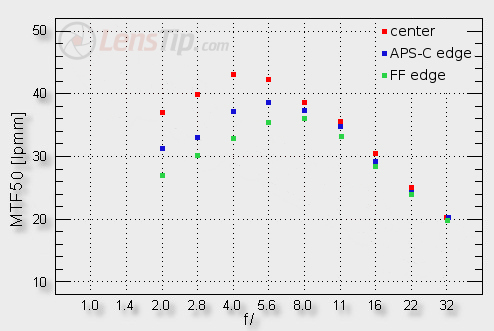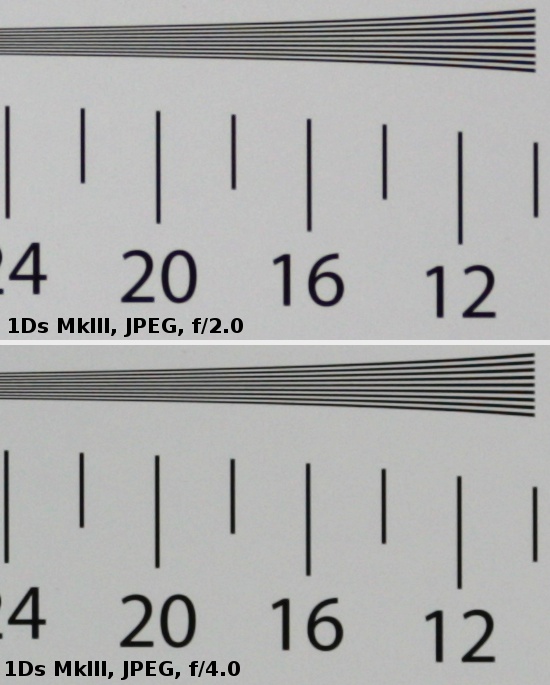Canon EF 135 mm f/2L USM
4. Image resolution
Let’s have a glance at the graph below to assess the performance of the tested lens in the frame centre, on the edge of the APS-C sensor and on the edge of full frame.

Please Support UsIf you enjoy our reviews and articles, and you want us to continue our work please, support our website by donating through PayPal. The funds are going to be used for paying our editorial team, renting servers, and equipping our testing studio; only that way we will be able to continue providing you interesting content for free. |
- - - - - - - - - - - - - - - - - - - - - - - - - - - - - - - - - - - - - - - - - - - - - - - -
First, the frame centre. You can notice at once that we deal here with a splendid optical instrument. Even at the maximum relative aperture the lens reaches 37 lpmm so gives fully sharp and satisfactory images. The peak of its possibilities is achieved by f/4.0, where the lens reaches 43 lpmm. It is a bit short of any records, because the best “primes” can go as high as 44-46 lpmm, but, in fact, it is the only trace that we deal here with an instrument designed 15 years ago. The MTF50 value, measured by us, is not only detail-sensitive but also sensitive to the overall photo resolution. In older constructions, which were optimized with photographic film in mind and had different anti-reflection coatings, reaching record MTF50 values is harder. Even applying newer coatings might not be very helpful. The efficiency of coatings depends not only on their quality but also on the kind of glass used. Contemporarily designed optical constructions boast coatings optimized at an early stage of lens designing, which fit the glass they are supposed to cooperate with. That’s why in an older construction the change of coatings might help a bit but still it most probably won’t provide such good results as in a new one, optimized for cooperation with a digital detector.
We wrote at length about a quite technical issue but our digressions don’t change the fact that the Canon 135L can provide images of excellent quality. The results lower by about 2 lpmm than those of some new “primes”, instruments additionally being the best on the market, would be difficult to notice in real life photos. The full usefulness of the maximum relative aperture and the results which are improving very fast on stopping down are much more important aspects here.
In a very similar tone we can comment the performance on the edge of the APS-C sensor. Even at the maximum relative aperture the image is fully useful and on stopping down the situation is even improved. The only reservation can concern the image resolution on the very edge of full frame and only at the maximum relative aperture – the value, reached there, is a bit worse than useful but if you close the aperture down to f/2.8 you can eliminate that problem completely and then you can enjoy a good or even very good image across the frame.
This chapter can be summarized very shortly: an old but hale and hearty lens. The Canon 135L, despite its age, is able to put much younger lenses to shame.
Below we present some crops of our test chart photos, taken from the frame centre and saved in JPEG format.
 |






